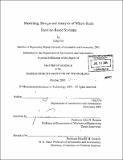| dc.contributor.advisor | John G. Brisson. | en_US |
| dc.contributor.author | Cui, Ling, 1978- | en_US |
| dc.contributor.other | Massachusetts Institute of Technology. Dept. of Aeronautics and Astronautics. | en_US |
| dc.date.accessioned | 2005-06-02T18:33:41Z | |
| dc.date.available | 2005-06-02T18:33:41Z | |
| dc.date.copyright | 2003 | en_US |
| dc.date.issued | 2004 | en_US |
| dc.identifier.uri | http://hdl.handle.net/1721.1/17764 | |
| dc.description | Thesis (S.M.)--Massachusetts Institute of Technology, Dept. of Aeronautics and Astronautics, February 2004. | en_US |
| dc.description | Includes bibliographical references (p. 148-149). | en_US |
| dc.description.abstract | This thesis presents the modeling and design of two major types of micro Rankine-cycle-based machines: a single-Rankine-based power system and a waste-heat-driven cooler. As part of the Massachusetts Institute of Technology (MIT) Micro Engine Project, these projected machines can be combined with the MIT micro gas turbine engines to improve their overall performance. The models were based on the conventional heat transfer and fluid mechanics correlations. And the state-of-the-art turbomachinery technologies and fabrication capability were taken into consideration in the designing of these devices. The results show that the single-Rankine bottoming power system could provide as high as 37-watt power when it is combined with a micro gas turbine engine, given a one square inch footprint and 50% turbomachinery efficiency. The waste-heat-driven cooler, or the heat pump, could provide air-conditioning and condensed water when it is combined to a micro gas turbine engine. Within a footprint of 7 cm by 7 cm, it could generate a 25-watt total cooling power. The amount of effective cooling (air-conditioning) power and condensed water is highly dependent on the ambient temperature and humidity. Micro heat exchanger designs for the above Rankine machines were also delineated in this thesis. The traditional fin-type heat exchanger and a new low-pressure-drop hole-type heat exchanger were discussed. All of these heat exchangers are within the realm of the state-of-the-art fabrication capabilities. At the end of the thesis, the challenges of bringing these micro Rankine machines into reality were also discussed and some possible solutions were proposed. This work broadens the variety of the micro power systems. It is not intended to be framed in a single | en_US |
| dc.description.abstract | (cont.) specific device, but rather, it presents the measures and expanse of the micro-Rankine-machine designs. | en_US |
| dc.description.statementofresponsibility | by Ling Cui. | en_US |
| dc.format.extent | 149 p. | en_US |
| dc.format.extent | 7830481 bytes | |
| dc.format.extent | 7847204 bytes | |
| dc.format.mimetype | application/pdf | |
| dc.format.mimetype | application/pdf | |
| dc.language.iso | eng | en_US |
| dc.publisher | Massachusetts Institute of Technology | en_US |
| dc.rights | M.I.T. theses are protected by copyright. They may be viewed from this source for any purpose, but reproduction or distribution in any format is prohibited without written permission. See provided URL for inquiries about permission. | en_US |
| dc.rights.uri | http://dspace.mit.edu/handle/1721.1/7582 | |
| dc.subject | Aeronautics and Astronautics. | en_US |
| dc.title | Modeling, design and analysis of micro-scale Rankine-based systems | en_US |
| dc.type | Thesis | en_US |
| dc.description.degree | S.M. | en_US |
| dc.contributor.department | Massachusetts Institute of Technology. Department of Aeronautics and Astronautics | |
| dc.identifier.oclc | 56526101 | en_US |

